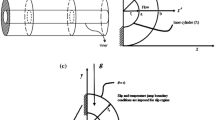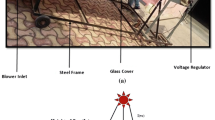Abstract
Jet impingement heat transfer finds applications where a large heat flux is required between a fluid and a surface. Impinging jets can be implemented in Concentrating Solar Power (CSP) thermal receivers and bayonet tube heat exchangers. A simultaneous outlook on the heat transfer and total pressure loss (performance) characteristics of several jets impinging on a concave hemispherical surface are investigated experimentally and using an axisymmetric Reynolds averaged Navier Stokes (RANS) Computational Fluid Dynamics (CFD) model. The four equation Transition SST RANS turbulence CFD model demonstrates to be most suitable for this domain with a mean absolute deviation from the experimental results of < 7% for the heat transfer coefficient and < 8% for the total pressure loss. Empirical correlations for the Nusselt number as a function of the nozzle outlet Reynolds number and Prandtl number are fitted. Relatively good agreement is found between the Nusselt correlation and existing literature. An empirical correlation is also presented for the total pressure loss factor for the jet impingement domain in general because it is found that the dominating total pressure loss occurs because of rapid expansion, which occurs in any impinging free jet. The developed empirical correlations and CFD model can be used to estimate the heat transfer and pressure loss characteristics of a bayonet tube heat exchanger, a solar thermal receiver employing impinging jets as well as other jet impingement domains.




























Similar content being viewed by others
Notes
This pipe has a diameter of 25 mm and is 399 mm long.
Abbreviations
- A :
-
Area (m2)
- d :
-
Nozzle diameter (m)
- D :
-
Impingement surface diameter (m)
- f d :
-
Darcy friction factor (-)
- h :
-
Heat transfer coefficient (W/(m2 K))
- k :
-
Thermal conductivity (W/(m K))
- k :
-
Turbulence kinetic energy (m2/s2)
- L :
-
Jet to impingement surface distance (m)
- \(\dot {m}\) :
-
Mass flow rate (kg/s)
- N u :
-
Nusselt number (-)
- p :
-
Pressure (Pa)
- P r :
-
Prandtl number (-)
- \(\dot {Q}\) :
-
Heat rate (W)
- \(\dot {q}\) :
-
Heat flux (W/m2)
- r :
-
Surface radius from stagnation point (m)
- R e :
-
Reynolds number (-)
- T :
-
Temperature (°C)
- TI :
-
Turbulence intensity (-)
- u :
-
Velocity (m/s)
- y + :
-
Dimensionless distance from a wall (-)
- ε :
-
Roughness constant (-)
- μ :
-
Dynamic viscosity (kg/(m s))
- ξ :
-
Loss coefficient (-)
- ρ :
-
Density (kg/m3)
- ω :
-
Specific turbulence dissipation rate (1/s)
- al:
-
Aluminium
- cond:
-
Condensation
- dyn:
-
Dynamic
- exp:
-
Expansion
- es:
-
Exterior heat transfer surface
- fg:
-
Latent heat
- is:
-
Interior heat transfer surface
- l:
-
Liquid
- n:
-
Nozzle
- sat:
-
Saturation
- sph:
-
Sphere
- t:
-
Total
- tc:
-
Total, component
- v:
-
Vapour
References
Alzoubi MA, Sasmito AP (2017) Thermal performance optimization of a bayonet tube heat exchanger. Appl Therm Eng 111:232. https://doi.org/10.1016/j.applthermaleng.2016.09.052
Ma T, Zeng M, Ji Y, Zhu H, Wang Q (2011) Investigation of a novel bayonet tube high temperature heat exchanger with inner and outer fins. Int J Hydrogen Energy 36(5):3757. https://doi.org/10.1016/j.ijhydene.2010.12.039
Damiani L, Montecucco M, Prato AP (2013) Conceptual design of a bayonet-tube steam generator for the ALFRED lead-cooled reactor. Nucl Eng Des 265:154. https://doi.org/10.1016/j.nucengdes.2013.06.021
Han B, Goldstein RJ (2001) Jet-impingement heat transfer in gas turbine systems. Ann N Y Acad Sci 934:147. https://doi.org/10.1111/j.1749-6632.2001.tb05849.x
Kröger DG (2008) Spiky Central Receiver Air Pre-heater (SCRAP). Tech. rep., Stellenbosch University
Lubkoll M, Erasmus DJ, Harms TM, Von Backström TW, Kröger DG (2020) Performance characteristics of the Spiky Central Receiver Air Pre-heater (SCRAP). Sol Energy 201:773. https://doi.org/10.1016/j.solener.2020.03.027
Wang W, Laumert B, Xu H, Strand T (2015) Conjugate heat transfer analysis of an impinging receiver design for a dish-Brayton system. Sol Energy 119:298. https://doi.org/10.1016/j.solener.2015.07.013
Li L (2014) Numerical study of surface heat transfer enhancement in an impinging solar receiver. Master’s thesis, Uppsala University. http://urn.kb.se/resolve?urn=urn:nbn:se:uu:diva-237365
Wang W, Laumert B (2018) An axial type impinging receiver. Energy 162:318. https://doi.org/10.1016/j.energy.2018.08.036
Garbrecht O (2012) Solarturmkraftwerk-Solarempfänger. http://www.google.com/patents/EP2520872A1?cl=en
Goldstein R, Behbahani A, Heppelmann K (1986) Streamwise distribution of the recovery factor and the local heat transfer coefficient to an impinging circular air jet. Int J Heat Mass Transf 29(8):1227. https://doi.org/10.1016/0017-9310(86)90155-9
Lee DH, Chung YS, Won SY (1999) The effect of concave surface curvature on heat transfer from a fully developed round impinging jet. Int J Heat Mass Transf 42(13):2489. https://doi.org/10.1016/S0017-9310(98)00318-4
Craig KJ, Slootweg M, Meyer JP, Robbins JC, Kotzé R, Honiball NJM, Grobler E, Oosthuizen TJ, Winterbach W (2018) CFD Simulation of solar receiver jet impingement heat transfer: RANS vs LES. In 16th International heat transfer conference, 23262, pp 1971–1978 https://doi.org/10.1615/IHTC16.cms.023262
Uddin N, Neumann SO, Weigand B (2013) LES simulations of an impinging jet: On the origin of the second peak in the Nusselt number distribution. Int J Heat Mass Transf 57(1):356. https://doi.org/10.1016/j.ijheatmasstransfer.2012.10.052
Grenson P, Deniau H (2017) Large-Eddy simulation of an impinging heated jet for a small nozzle-to-plate distance and high Reynolds number. Int J Heat Fluid Flow 68:348. https://doi.org/10.1016/j.ijheatfluidflow.2017.09.014
Achari AM, Das MK (2015) Application of various RANS based models towards predicting turbulent slot jet impingement. Int J Therm Sci 98:332. https://doi.org/10.1016/j.ijthermalsci.2015.07.018
Issac J, Singh D, Kango S (2020) Experimental and numerical investigation of heat transfer characteristics of jet impingement on a flat plate. Heat Mass Transf 56 (2):531. https://doi.org/10.1007/s00231-019-02724-9
McDougall D (2019) Numerical simulation of jet impingement cooling of the inside of a hemisphere with application to SCRAP. Master’s thesis, Stellenbosch University. http://hdl.handle.net/10019.1/106154
VDI (2010) VDI-Wärmeatlas, 10th edn. VDI-Verlag, Duesseldorf
Çengel YA, Ghajar AJ (2011) Heat and mass transfer: Fundamentals and applications, 4th edn. McGraw-Hill Inc., New York
Kröger DG (2004) Air-cooled heat exchangers and cooling towers, 1st edn. University of Stellenbosch
Çengel Y., Cymbala J (2014) Fluid mechanics fundamentals and applications, 3rd edn. McGraw-Hill, New York
Taylor J (1997) An introduction to error analysis: The study of uncertainties in physical measurement, 2nd edn. University Science Books, USA
Reynolds O (1895) On the dynamical theory of incompressible viscous fluids and the determination of the criterion. Philosophical Transactions of the Royal Society of London Series A 186:123. https://doi.org/10.1098/rsta.1895.0004
Menter FR (1993) Zonal Two Equation Kappa-Omega Turbulence Models for Aerodynamic Flows. AIAA Paper 93-2906. https://ntrs.nasa.gov/search.jsp?R=19960044572
Langtry RB, Menter FR (2009) Correlation-based transition modeling for unstructured parallelized computational fluid dynamics codes. AIAA J 47(12):2894. https://doi.org/10.2514/1.42362
Versteeg H, Malalasekera W (2007) An introduction to computational fluid dynamics, 2nd edn. Pearson, Glasgow
Schlünder EU, Gnielinski V (1967) Wärme- und Stoffübertragung zwischen Gut und aufprallendem Düsenstrahl. Chemie Ingenieur Technik 39(9-10):578. https://onlinelibrary.wiley.com/doi/abs/10.1002/cite.330390915
Goldstein RJ, Seol W (1991) Heat transfer to a row of impinging circular air jets including the effect of entrainment. Int J Heat Mass Transf 34(8):2133. https://doi.org/10.1016/0017-9310(91)90223-2
Bunker RS, Metzger DE (1990) Local heat transfer in internally cooled turbine airfoil leading edge regions: Part I – Impingement cooling without film coolant extraction. J Turbomach 112(3):451. https://doi.org/10.1115/1.2927680
Chupp RE, Helms HE, Mcfadden PW, Brown TR (1969) Evaluation of internal heat-transfer coefficients for impingement-cooled turbine airfoils. J Aircr 6(3):203. https://doi.org/10.2514/3.44036
Fives North American Combustion Inc. (2001) North American Combustion Handbook. https://doi.org/https://app.knovel.com/hotlink/toc/id:kpCHVIE001/north-american-combustion/north-american-combustion, 3rd edn. Fives North American Combustion, Inc., Cleveland, p 85
Mikron Instrument Company (2003) Table of emissivity of various surfaces (Mikron Instrument Company Inc). https://doi.org/http://www-eng.lbl.gov/dw/projects/DW4229_LHC_detector_analysis/calculations/emissivity2.pdf
Çengel Y. A., Boles MA (2014) Thermodynamics: An engineering approach, 8th edn. McGraw-Hill Education, New York
White FM (2006) Viscous fluid flow, vol 3, 3rd edn. McGraw-Hill, New York
Acknowledgements
The authors thank Prof. Ken Craig, Mr. Jesse Quick and Mr. David McDougall for their advice on CFD modelling. The support of the Solar Thermal Energy Research Group (STERG) is appreciated. The assistance and guidance of the Mechanical and Mechatronic Engineering workshop is also appreciated. The value of the HPC1 (Rhasatsha) high performance computer at the University of Stellenbosch is acknowledged.
Author information
Authors and Affiliations
Corresponding author
Ethics declarations
Conflict of interests
On behalf of all authors, the corresponding author states that there is no conflict of interest.
Additional information
Publisher’s note
Springer Nature remains neutral with regard to jurisdictional claims in published maps and institutional affiliations.
Rights and permissions
About this article
Cite this article
Erasmus, D.J., Lubkoll, M. & Backström, T.W.v. Jet impingement heat transfer within a hemisphere. Heat Mass Transfer 57, 931–948 (2021). https://doi.org/10.1007/s00231-020-02977-9
Received:
Accepted:
Published:
Issue Date:
DOI: https://doi.org/10.1007/s00231-020-02977-9




